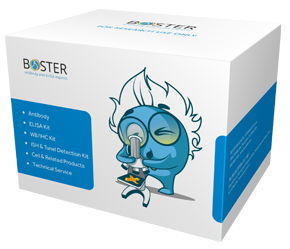Product Info Summary
| SKU: | M02675-4 |
|---|---|
| Size: | 0.1 mg |
| Reactive Species: | Human, Mouse |
| Host: | Mouse |
| Application: | Flow Cytometry, IP, IHC-F, ICC, WB |
Customers Who Bought This Also Bought
Product info
Product Name
Anti-CD3 epsilon (activation epitope) Purified Monoclonal Antibody
SKU/Catalog Number
M02675-4
Size
0.1 mg
Form
Liquid
Description
Boster Bio Anti-CD3 epsilon (activation epitope) Purified Monoclonal Antibody (Catalog# M02675-4). Tested in Flow Cytometry, IP, WB, IHC-F, ICC application(s). This antibody reacts with Mouse, Human.
Storage & Handling
Store at 2-8°C. Do not freeze.
Cite This Product
Anti-CD3 epsilon (activation epitope) Purified Monoclonal Antibody (Boster Biological Technology, Pleasanton CA, USA, Catalog # M02675-4)
Host
Mouse
Contents
Phosphate buffered saline (PBS), pH 7.4, 15 mM sodium azide
Clonality
Monoclonal
Clone Number
APA1/1
Isotype
Mouse IgG1
Immunogen
Purified human CD3 proteins isolated from thymus. The mouse monoclonal antibody APA1/1 recognizes an activation-dependent intracellular epitope of CD3 epsilon. Exposure of the epitope precedes CD3 phosphorylation and recruitment and activation of ZAP70, which initiates the signaling cascade produced by T-cell activation. APA1/1 provides the earliest known marker for TCR-mediated T cell activation.
*Blocking peptide can be purchased. Costs vary based on immunogen length. Contact us for pricing.
Cross-reactivity
This antibody does not cross-react with Thy-1.1 alloantigen.
Reactive Species
M02675-4 is reactive to CD3E in Human, Mouse
Reconstitution
Observed Molecular Weight
42 kDa
Calculated molecular weight
23147 MW
Background of CD3E
CD3 complex is crucial in transducing antigen-recognition signals into the cytoplasm of T cells and in regulating the cell surface expression of the TCR complex. T cell activation through the antigen receptor (TCR) involves the cytoplasmic tails of the CD3 subunits CD3 gamma, CD3 delta, CD3 epsilon and CD3 zeta. These CD3 subunits are structurally related members of the immunoglobulins super family encoded by closely linked genes on human chromosome 11. The CD3 components have long cytoplasmic tails that associate with cytoplasmic signal transduction molecules. This association is mediated at least in part by a double tyrosine-based motif present in a single copy in the CD3 subunits. CD3 may play a role in TCR-induced growth arrest, cell survival and proliferation.
Antibody Validation
Boster validates all antibodies on WB, IHC, ICC, Immunofluorescence, and ELISA with known positive control and negative samples to ensure specificity and high affinity, including thorough antibody incubations.
Application & Images
Applications
M02675-4 is guaranteed for Flow Cytometry, IP, IHC-F, ICC, WB Boster Guarantee
Assay Dilutions Recommendation
The recommendations below provide a starting point for assay optimization. The actual working concentration varies and should be decided by the user.
Flow cytometry: Intracellular staining; recommended dilution: 1-4 µg/ml; positive control: human T cells stimulated with anti-CD3 (MEM-57) antibody (1 μg/ml). Sample preparation: At the end of stimulation of T cells, perform staining of surface markers (if required) in PBS + 0.1% BSA for 20 min. on ice. Wash with PBS and fix with 2% formaldehyde, 30 min on ice. Wash with PBS and incubate in PBS + 0,1% saponine, 5 min. RT. Incubate the cells in PBS + 1% BSA + 0.03% saponine, 15 min. on ice. Incubate with fluorescence-labeled APA1/1 antibody (1-2 μg/ml) in PBS + 1% BSA + 0.03% saponine in dark, 20 min. RT. Wash with PBS + 1% BSA + 0.03% saponine, resuspend in PBS.
Immunocytochemistry: Fixed and permeabilised cells. The antibody can distinguish TCR-stimulated from non-stimulated cells.
Validation Images & Assay Conditions
There are currently no images for this product. We are working on uploading them please check back shortly or contact us to expedite our upload process for this antibody.
Protein Target Info & Infographic
Gene/Protein Information For CD3E (Source: Uniprot.org, NCBI)
Gene Name
CD3E
Full Name
T-cell surface glycoprotein CD3 epsilon chain
Weight
23147 MW
Alternative Names
CD3 epsilon chain, T3E, IMD18 CD3E IMD18, T3E, TCRE CD3e molecule T-cell surface glycoprotein CD3 epsilon chain|CD3-epsilon|CD3e , epsilon polypeptide (TiT3 complex)|CD3e molecule, epsilon (CD3-TCR complex)|T-cell receptor complex, epsilon subunit of T3|T-cell surface T3/Leu-4 epsilon chain
*If product is indicated to react with multiple species, protein info is based on the gene entry specified above in "Species".For more info on CD3E, check out the CD3E Infographic

We have 30,000+ of these available, one for each gene! Check them out.
In this infographic, you will see the following information for CD3E: database IDs, superfamily, protein function, synonyms, molecular weight, chromosomal locations, tissues of expression, subcellular locations, post-translational modifications, and related diseases, research areas & pathways. If you want to see more information included, or would like to contribute to it and be acknowledged, please contact [email protected].
Specific Publications For Anti-CD3 epsilon (activation epitope) Purified Monoclonal Antibody (M02675-4)
Hello CJ!
No publications found for M02675-4
*Do you have publications using this product? Share with us and receive a reward. Ask us for more details.
Recommended Resources
Here are featured tools and databases that you might find useful.
- Boster's Pathways Library
- Protein Databases
- Bioscience Research Protocol Resources
- Data Processing & Analysis Software
- Photo Editing Software
- Scientific Literature Resources
- Research Paper Management Tools
- Molecular Biology Software
- Primer Design Tools
- Bioinformatics Tools
- Phylogenetic Tree Analysis
Customer Reviews
Have you used Anti-CD3 epsilon (activation epitope) Purified Monoclonal Antibody?
Submit a review and receive an Amazon gift card.
- $30 for a review with an image
0 Reviews For Anti-CD3 epsilon (activation epitope) Purified Monoclonal Antibody
Customer Q&As
Have a question?
Find answers in Q&As, reviews.
Can't find your answer?
Submit your question




